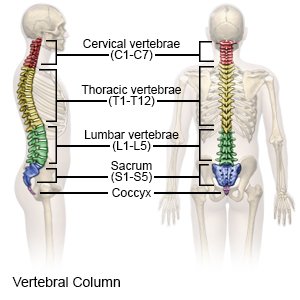Cervical Spinal Stenosis
Medically reviewed by Drugs.com. Last updated on Apr 6, 2025.
What is cervical spinal stenosis?
Cervical spinal stenosis is narrowing of the spinal canal in your neck. Your spinal canal holds your spinal cord. When your spinal canal narrows, it may put pressure on your spinal cord. Cervical spinal stenosis is a chronic (long-term) condition.
 |
What causes cervical spinal stenosis?
Cervical spinal stenosis is usually caused by the breakdown of discs in your cervical spine. Discs are tough, spongy cushions between your vertebrae (bones) that help move your neck. This breakdown naturally happens as you age. Problems with the muscles or bones in your neck may also cause cervical spinal stenosis. The vertebrae in your spine may weaken and slip out of place. Ligaments in your neck may thicken and harden. Accidents or injuries can also damage your vertebrae and narrow your spinal canal.
What are the signs and symptoms of cervical spinal stenosis?
You may have no signs or symptoms. If your spinal canal is very narrow, your signs and symptoms may be worse. You may have any of the following:
- Neck pain and headaches
- Burning pain that shoots from your shoulder down your arm
- Weakness, numbness, or tingling in your arm or hand, which may spread to your legs
- Trouble urinating or having a bowel movement
- Trouble with balance and walking
- Trouble holding your neck up or trouble standing up straight
How is cervical spinal stenosis diagnosed?
Your healthcare provider will ask about your medical history and your symptoms. He or she will check the feeling, strength, and movement of your arms and legs. An x-ray, MRI or a CT may show problems in your cervical spine that are causing spinal stenosis. You may be given contrast liquid to help the area show up better in the pictures. Tell the healthcare provider if you have ever had an allergic reaction to contrast liquid. Do not enter the MRI room with anything metal. Metal can cause serious injury. Tell the healthcare provider if you have any metal in or on your body.
How is cervical spinal stenosis treated?
- NSAIDs , such as ibuprofen, help decrease swelling and pain. NSAIDs can cause stomach bleeding or kidney problems in certain people. If you take blood thinner medicine, always ask your healthcare provider if NSAIDs are safe for you. Always read the medicine label and follow directions.
- Acetaminophen decreases pain and fever. It is available without a doctor's order. Ask how much to take and how often to take it. Follow directions. Read the labels of all other medicines you are using to see if they also contain acetaminophen, or ask your doctor or pharmacist. Acetaminophen can cause liver damage if not taken correctly.
- Prescription pain medicine may be given. Ask how to take this medicine safely.
- Muscle relaxers help decrease pain and muscle spasms.
- A steroid injection may be given to reduce inflammation. Steroid medicine is injected into the epidural space. The epidural space is the area between your spinal cord and vertebrae.
- A nerve block is an injection of numbing medicine. You may need a nerve block if your pain is not going away, or is getting worse.
- Surgery may be needed to widen your spinal canal or decrease pressure on your spinal cord. Surgery also may be done to fix damaged or injured vertebrae in your neck.
How can I manage my symptoms?
- Go to physical and occupational therapy as directed. A physical therapist teaches you exercises to help improve movement and strength, and to decrease pain. An occupational therapist teaches you skills to help with your daily activities.
- Apply heat on your neck for 20 to 30 minutes every 2 hours for as many days as directed. Heat helps decrease pain and muscle spasms.
- Apply ice on your neck for 15 to 20 minutes every hour or as directed. Use an ice pack, or put crushed ice in a plastic bag. Cover it with a towel before you apply it to your skin. Ice helps prevent tissue damage and decreases swelling and pain.
- Avoid certain activities. Some activities may worsen your condition or cause more injury. Do not ride motorcycles or horses, climb ladders, or play football or other contact sports. Ask your provider which activities are safe for you to do.
When should I seek immediate care?
- You injure your neck, and your pain and symptoms worsen.
- You have new or increased trouble walking.
- You cannot control when you urinate or have a bowel movement.
- You have more numbness, tingling, or weakness than before.
When should I contact my healthcare provider?
- Your pain does not get better or gets worse, even after you take medicine.
- You have questions or concerns about your condition or care.
Care Agreement
You have the right to help plan your care. Learn about your health condition and how it may be treated. Discuss treatment options with your healthcare providers to decide what care you want to receive. You always have the right to refuse treatment. The above information is an educational aid only. It is not intended as medical advice for individual conditions or treatments. Talk to your doctor, nurse or pharmacist before following any medical regimen to see if it is safe and effective for you.© Copyright Merative 2025 Information is for End User's use only and may not be sold, redistributed or otherwise used for commercial purposes.
Further information
Always consult your healthcare provider to ensure the information displayed on this page applies to your personal circumstances.
